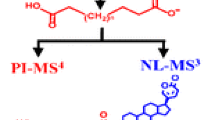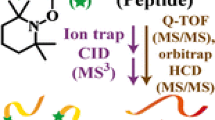Abstract
Comprehensive analysis and identification of chemical components are of great significance for evaluating the efficacy and safety of herbal medicines, as well as for drug exploitation and development. Here we developed a “force iteration molecular designing” strategy, by combing a database-based in-house software for a precursor ion list (PIL) and PIL-triggered collision-induced dissociation-MS2 and high-energy C-trap dissociation-MS2 (PIL-CID/MS2-HCD/MS2) on an LTQ-Orbitrap mass spectrometer, aiming for the systematic characterization and discovery of new protostane triterpenoids (PTs) from Alisma Rhizoma (AR). AR was a well-known herbal remedy widely used for diarrhea, but its systematic characterization and comparison between two botanical origins have not been reported. Firstly, in-house software was developed based on force iteration, to generate a PIL that contains 483 accurate precursor ions. Secondly, to facilitate the acquisition of rich fragments and diagnostic ions sufficient for the structural elucidation of different types of PTs, a hybrid data acquisition method, namely PIL-CID/MS2-HCD/MS2, was generated. Thirdly, a total of 473 PTs were rapidly characterized from two botanical origins of AR according to an established four-step interpretation method, and the common constituents were 277 with ratio 70% (277/395) and 78% (277/355) in the rhizome of Alisma plantago-aquatica and A. orientale, respectively. Finally, two new PTs were isolated and unambiguously identified by NMR verifying the feasibility of this combined data acquisition strategy. This integrated strategy could improve the efficiency in the detection of new compounds in a single run and is practical to comprehensively characterize the complex components in herbal medicines.








Similar content being viewed by others
References
Gu H, Zhang P, Zhu J, Raftery D. Globally optimized targeted mass spectrometry: reliable metabolomics analysis with broad coverage. Anal Chem. 2015;87(24):12355–62. https://doi.org/10.1021/acs.analchem.5b03812.
Fu LL, Ding H, Han LF, Jia L, Yang WZ, Zhang CX, et al. Simultaneously targeted and untargeted multicomponent characterization of Erzhi Pill by offline two-dimensional liquid chromatography/quadrupole-Orbitrap mass spectrometry. J Chromatogr A. 2019;1584:87–96. https://doi.org/10.1016/j.chroma.2018.11.024.
Johnson AR, Carlson EE. Collision-induced dissociation mass spectrometry: a powerful tool for natural product structure elucidation. Anal Chem. 2015;87(21):10668–78. https://doi.org/10.1021/acs.analchem.5b01543.
Ganzera M, Sturm S. Recent advances on HPLC/MS in medicinal plant analysis-an update covering 2011-2016. J Pharm Biomed Anal. 2018;147:211–33. https://doi.org/10.1016/j.jpba.2017.07.038.
Yao CL, Yang WZ, Si W, Shen Y, Zhang NX, Chen HL, et al. An enhanced targeted identification strategy for the selective identification of flavonoid O-glycosides from Carthamus tinctorius by integrating offline two-dimensional liquid chromatography/linear ion-trap-Orbitrap mass spectrometry, high-resolution diagnostic product ions/neutral loss filtering and liquid chromatography-solid phase extraction-nuclear magnetic resonance. J Chromatogr A. 2017;1491:87–97. https://doi.org/10.1016/j.chroma.2017.02.041.
Pan H, Yang W, Yao C, Shen Y, Zhang Y, Shi X, et al. Mass defect filtering-oriented classification and precursor ions list-triggered high-resolution mass spectrometry analysis for the discovery of indole alkaloids from Uncaria sinensis. J Chromatogr A. 2017;1516:102–13. https://doi.org/10.1016/j.chroma.2017.08.035.
Sun W, Tong L, Miao J, Huang J, Li D, Li Y, et al. Separation and analysis of phenolic acids from Salvia miltiorrhiza and its related preparations by off-line two-dimensional hydrophilic interaction chromatographyxreversed-phase liquid chromatography coupled with ion trap time-of-flight mass spectrometry. J Chromatogr A. 2016;1431:79–88. https://doi.org/10.1016/j.chroma.2015.12.038.
Chen Y, Zhou Z, Yang W, Bi N, Xu J, He J, et al. Development of a data-independent targeted metabolomics method for relative quantification using liquid chromatography coupled with tandem mass spectrometry. Anal Chem. 2017;89(13):6954–62. https://doi.org/10.1021/acs.analchem.6b04727.
Navarro-Reig M, Jaumot J, Baglai A, Vivo-Truyols G, Schoenmakers PJ, Tauler R. Untargeted comprehensive two-dimensional liquid chromatography coupled with high-resolution mass spectrometry analysis of rice metabolome using multivariate curve resolution. Anal Chem. 2017;89(14):7675–83. https://doi.org/10.1021/acs.analchem.7b01648.
Stoll DR, Carr PW. Two-dimensional liquid chromatography: a state of the art tutorial. Anal Chem. 2017;89(1):519–31. https://doi.org/10.1021/acs.analchem.6b03506.
Yao CL, Pan HQ, Wang H, Yao S, Yang WZ, Hou JJ, et al. Global profiling combined with predicted metabolites screening for discovery of natural compounds: characterization of ginsenosides in the leaves of Panax notoginseng as a case study. J Chromatogr A. 2018;1538:34–44. https://doi.org/10.1016/j.chroma.2018.01.040.
Qiu S, Yang WZ, Yao CL, Qiu ZD, Shi XJ, Zhang JX, et al. Nontargeted metabolomic analysis and “commercial-homophyletic” comparison-induced biomarkers verification for the systematic chemical differentiation of five different parts of Panax ginseng. J Chromatogr A. 2016;1453:78–87. https://doi.org/10.1016/j.chroma.2016.05.051.
Ma S, Chowdhury SK. Data acquisition and data mining techniques for metabolite identification using LC coupled to high-resolution MS. Bioanalysis. 2013;5(10):1285–97. https://doi.org/10.4155/bio.13.103.
Xie W, Jin Y, Hou L, Ma Y, Xu H, Zhang K, et al. A practical strategy for the characterization of ponicidin metabolites in vivo and in vitro by UHPLC-Q-TOF-MS based on nontargeted SWATH data acquisition. J Pharm Biomed Anal. 2017;145:865–78. https://doi.org/10.1016/j.jpba.2017.08.003.
Wei W, Hou J, Yao C, Bi Q, Wang X, Li Z, et al. A high-efficiency strategy integrating offline two-dimensional separation and data post-processing with dereplication: characterization of bufadienolides in Venenum Bufonis as a case study. J Chromatogr A. 1603;2019:179–89. https://doi.org/10.1016/j.chroma.2019.06.037.
Shi XJ, Yang WZ, Qiu S, Yao CL, Shen Y, Pan HQ, et al. An in-source multiple collision-neutral loss filtering based nontargeted metabolomics approach for the comprehensive analysis of malonyl-ginsenosides from Panax ginseng, P. quinquefolius, and P. notoginseng. Anal Chim Acta. 2017;952:59–70. https://doi.org/10.1016/j.aca.2016.11.032.
Takahashi R, Fujioka S, Oe T, Lee SH. Stable isotope labeling by fatty acids in cell culture (SILFAC) coupled with isotope pattern dependent mass spectrometry for global screening of lipid hydroperoxide-mediated protein modifications. J Proteome. 2017;166:101–14. https://doi.org/10.1016/j.jprot.2017.07.006.
Hou JJ, Zhang JQ, Yao CL, Bauer R, Khan IA, Wu WY, et al. Deeper chemical perceptions for better traditional Chinese medicine standards. Engineering. 2019;5(1):83–97. https://doi.org/10.1016/j.eng.2018.12.005.
Zhang JY, Wang ZJ, Zhang Q, Wang F, Ma Q, Lin ZZ, et al. Rapid screening and identification of target constituents using full scan-parent ions list-dynamic exclusion acquisition coupled to diagnostic product ions analysis on a hybrid LTQ-Orbitrap mass spectrometer. Talanta. 2014;124:111–22. https://doi.org/10.1016/j.talanta.2013.11.025.
Pan H, Yao C, Yang W, Yao S, Huang Y, Zhang Y, et al. An enhanced strategy integrating offline two-dimensional separation and step-wise precursor ion list-based raster-mass defect filter: characterization of indole alkaloids in five botanical origins of Uncariae Ramulus cum Unicis as an exemplary application. J Chromatogr A. 2018;1563:124–34. https://doi.org/10.1016/j.chroma.2018.05.066.
Tian T, Chen H, Zhao YY. Traditional uses, phytochemistry, pharmacology, toxicology and quality control of Alisma orientale (Sam.) Juzep: a review. J Ethnopharmacol. 2014;158 Pt A:373–87. doi:https://doi.org/10.1016/j.jep.2014.10.061.
Jin QH, Zhang JQ, Hou JJ, Lei M, Liu C, Wang X, et al. Novel C-17 spirost protostane-type triterpenoids from Alisma plantago-aquatica with anti-inflammatory activity in Caco-2 cells. Acta Pharm Sin B. 2019;9(4):809–18. https://doi.org/10.1016/j.apsb.2019.04.002.
Feng YL, Chen H, Tian T, Chen DQ, Zhao YY, Lin RC. Diuretic and anti-diuretic activities of the ethanol and aqueous extracts of Alismatis rhizoma. J Ethnopharmacol. 2014;154(2):386–90. https://doi.org/10.1016/j.jep.2014.04.017.
Xu F, Lu C, Wu Q, Gu W, Chen J, Fang F, et al. Studies on the lipid-regulating mechanism of alisol-based compounds on lipoprotein lipase. Bioorg Chem. 2018;80:347–60. https://doi.org/10.1016/j.bioorg.2018.07.001.
Zhang A, Sheng Y, Zou M. Antiproliferative activity of Alisol B in MDA-MB-231 cells is mediated by apoptosis, dysregulation of mitochondrial functions, cell cycle arrest and generation of reactive oxygen species. Bioorg Chem. 2017;87:110–7. https://doi.org/10.1016/j.biopha.2016.12.088.
Commission CP. Pharmacopoeia of the People's Republic of China. vol 1. Chinese Medical Science and Technology Press;2015.
Jin Q, Hou J, Zhang J, Zhou J, Wu W, Guo D. Research progress on effective material basis of Rhizoma Alismatis and reflection on existing quality problem. World Science and Technology. 2018;21(5):821–34.
Zhang A, Sheng Y, Zou M. Therapeutic potential of Rhizoma Alismatis: a review on ethnomedicinal application, phytochemistry, pharmacology, and toxicology. Ann N Y Acad Sci. 2017;1401(1):90–101. https://doi.org/10.1111/nyas.13381.
Shu ZH, Pu J, Chen L, Zhang YB, Rahman K, Qin LP, et al. Alisma orientale: Ethnopharmacology, phytochemistry and pharmacology of an important traditional Chinese medicine. Am J Chinese Med. 2016;44(2):227–51. https://doi.org/10.1142/S0192415x16500142.
Chen X, Geng C, Zhang X, Li T, Chen J. Global identification strategy based on mass spectrometry for studying protostane triterpenoids in rhizomes of Alisma orientalis. Int J Mass Spectrom. 2017;414:70–9. https://doi.org/10.1016/j.ijms.2017.01.004.
Li S, Jin S, Song C, Jia S, Zhang Y, Feng Y, et al. The strategy for establishment of the multiple reaction monitoring based characteristic chemical profile of triterpenes in Alismatis rhizoma using two combined tandem mass spectrometers. J Chromatogr A. 2017;1524:121–34. https://doi.org/10.1016/j.chroma.2017.09.057.
Pan H, Yang W, Zhang Y, Yang M, Feng R, Wu W, et al. An integrated strategy for the systematic characterization and discovery of new indole alkaloids from Uncaria rhynchophylla by UHPLC/DAD/LTQ-Orbitrap-MS. Anal Bioanal Chem. 2015;407(20):6057–70. https://doi.org/10.1007/s00216-015-8777-0.
Bi QR, Hou JJ, Yang M, Shen Y, Qi P, Feng RH, et al. A strategy combining higher energy C-trap dissociation with neutral loss- and product ion-based MS(n) acquisition for global profiling and structure annotation of fatty acids conjugates. J Am Soc Mass Spectrom. 2017;28(3):443–51. https://doi.org/10.1007/s13361-016-1558-y.
Shi X, Yang W, Huang Y, Hou J, Qiu S, Yao C, et al. Direct screening of malonylginsenosides from nine ginseng extracts by an untargeted profiling strategy incorporating in-source collision-induced dissociation, mass tag, and neutral loss scan on a hybrid linear ion-trap/Orbitrap mass spectrometer coupled to ultra-high performance liquid chromatography. J Chromatogr A. 2018;1571:213–22. https://doi.org/10.1016/j.chroma.2018.08.026.
Murayama M, Oosawa T. Diuretic protost-13(17)-ene-3,16-diones from Alismataceae. Sanwa Seiyaku Co, Ltd, Japan; Application: JP1989:p. 8 pp.
Funding
This research was supported by the National Key R&D Program of China (Grant No. 2019YFC1711000) and National Natural Science Foundation of China (Grant No. 81530095).
Author information
Authors and Affiliations
Corresponding author
Ethics declarations
Conflict of interest
The authors declare that they have no competing interests.
Additional information
Publisher’s note
Springer Nature remains neutral with regard to jurisdictional claims in published maps and institutional affiliations.
Supplementary information
ESM 1
(PDF 2413 kb)
Rights and permissions
About this article
Cite this article
Zhang, J., Jin, Q., Wu, W. et al. “Force iteration molecular designing” strategy for the systematic characterization and discovery of new protostane triterpenoids from Alisma Rhizoma by UHPLC/LTQ-Orbitrap-MS. Anal Bioanal Chem 413, 1749–1764 (2021). https://doi.org/10.1007/s00216-020-03145-y
Received:
Revised:
Accepted:
Published:
Issue Date:
DOI: https://doi.org/10.1007/s00216-020-03145-y




